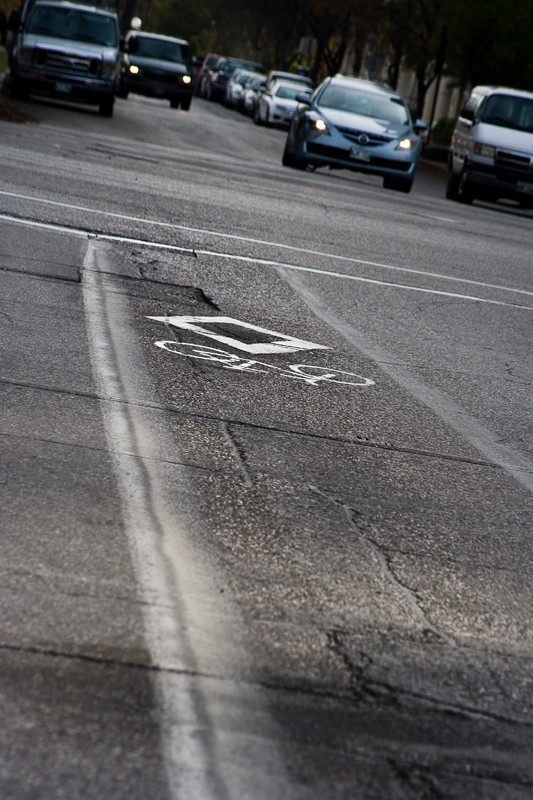City’s active transportation infrastructure grows
Cyclists offer mixed reviews
Many cyclists celebrated the $20 million the City of Winnipeg put into active transportation infrastructure last year, but it may be some time before University of Winnipeg commuters notice a major effect.
The tab was split three ways between the city, province, and federal government, as a result of the federal economic stimulus program. Thirty projects were completed in 2010, and six were to be completed in 2011.
Kevin Nixon, the city’s active transit co-ordinator, said Sherbrook Street will be left for next year, and they’re still working on St. Matthews Avenue, the nearest project to the U of W. The St. Matthews project, like most in the downtown, will involve a bike lane painted on the street.
In the future, Nixon said, the St. Matthews route will connect to Maryland Street.
“Obviously down the road we want to connect that route to the U of W in some way. We’re not sure how that’s going to happen,” he said.
Curt Hull of Bike to the Future said the 2010 developments enhanced the ride-ability of the city tremendously. For those who follow the law against passing on the right, bike lanes make it much more attractive to cycle in rush hour, he said.
“If there’s a lineup of cars waiting to get over the Osborne Bridge, you’re going to be at the back, sucking in tailpipe fumes, waiting until the traffic moves across the bridge,” he said. “But with a bike lane ... you just zoom by all of those cars that are waiting in line.”
Hull hopes riders’ positive experiences on improved routes will increase the demand to expand the improvements.
However, Robin Bryan of the U of W Ice Riders doesn’t see painted bike lanes having much effect for downtown cyclists.
He said other cities, like Montreal, have bike lanes separated from traffic by physical barriers. He sees that as the only way to make less confident cyclists feel safe on downtown streets.
“To the really avid confident cyclists, it doesn’t make a difference whether or not there are bike lanes, we’ll still bike on them,” he said.
But for others, he said, a line on the road - in between traffic and parked cars, and close enough to parked cars that doors will still be a threat - is not all that reassuring.
“I don’t see it making people who don’t normally feel safe on the road feel that much safer,” he said.
Nixon said the lanes on Assiniboine Avenue are exactly the sort of physically divided lanes that exist in Montreal. Ideally, pedestrians, cyclists and motorists should be separated, but it’s difficult to do downtown, he said.
“That is very difficult without having to either remove vehicle capacity or parking or something like that,” he said.
“ To the really avid confident cyclists, it doesn’t make a difference whether or not there’s bike lanes, we’ll still bike on the road.
Robin Bryan, Ice Riders
Bryan says the city cares more about parking than bikes.
“You can see where their vision and their allegiances really lie,” he said.
As to whether the new infrastructure has increased the number of cyclists, Nixon said it depends on the location.
“Assiniboine Avenue’s a great example. There’s a ton of people using it. Maryland I think we’re seeing quite a bit - I think we’ll see more once we get Sherbrook done.”
Numbers growing
Janice Lukes of the Winnipeg Trails Association sees cyclists’ numbers growing.
“You talk to any bike shop owner, and you ask them if there’s been more bike purchases and more supplies, and it’s absolutely,” she said.
According to Winnipeg police, crashes between cars and bikes were down 40 per cent in 2011. They attributed the drop to good weather and the new bike lanes. Both Lukes and Hull said there is safety in numbers for cyclists on the road.
“As we get more cyclists on the roads, motorists - it’s not worth their time to yell at the cyclist, because there’s another one down the street anyway,” Hull said, “So they learn to tolerate them.”
Hull said what is sorely lacking is practical education for cyclists, like driver’s ed, to give them the skills to feel safe on the road.
“Having infrastructure is one thing, but having skills in your pocket gives you that comfort. So if you put those two together, then we’ll have a lot more people choosing to ride.”
Bryan also sees a real need for education, but for motorists. He would like to see public awareness campaigns, like those against drunk driving, educating drivers on where their rights begin and end as drivers, and what rights cyclists have.
“I don’t think it’s clear to a lot of people what is within their responsibility as a driver, and what is frankly illegal,” he said.
What Lukes believes Manitoba needs most is a provincial active transportation policy, and an active transportation director. Lukes chairs Manitoba’s Active Transportation Advisory Group.
“The province is critical in all of this,” Lukes said. “In the city, too.”
Published in Volume 66, Number 9 of The Uniter (October 26, 2011)







